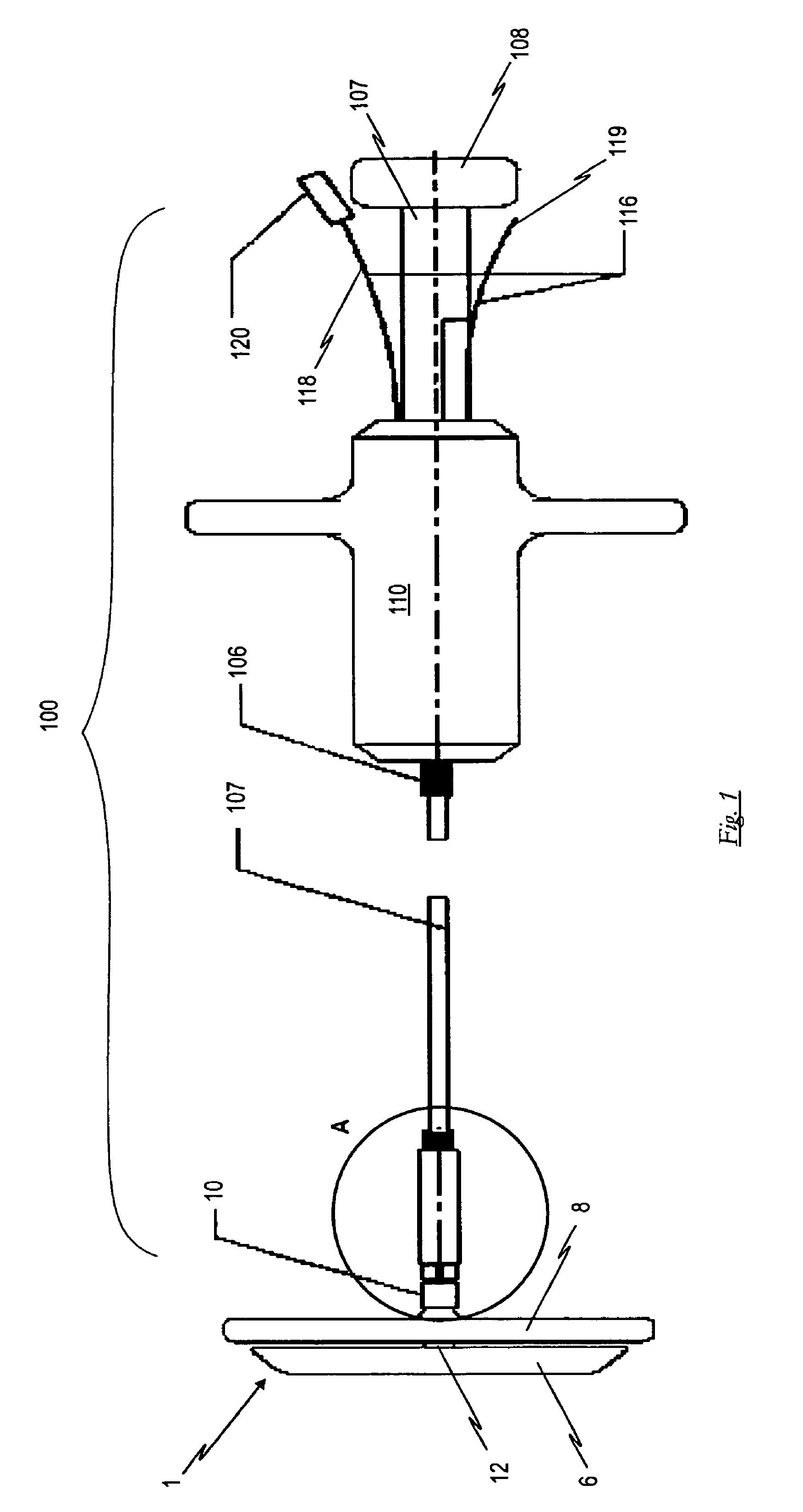Occlusion device and surgical instrument and method for its implantation/explantation
a technology which is applied in the field of occlusion device and surgical instrument and method for its implantation/explantation, can solve the problems of occlusion device being relatively complicated, difficult and complex implantation procedure, and umbrellas being susceptible to material fatigue, and achieves the effect of convenient and reliable manipulation of occlusion devi
- Summary
- Abstract
- Description
- Claims
- Application Information
AI Technical Summary
Benefits of technology
Problems solved by technology
Method used
Image
Examples
first embodiment
[0067]FIGS. 1 and 2 show a side and detail view of a surgical instrument 100 for the implantation and explantation of an implant serving here as an example of an implant coupled to an occlusion device 1. Surgical instrument 100 exhibits gripper tongs 102, the gripping jaws 103, 104, 105 of which can be opened and closed by means of a push / pull system. The inside areas of gripping jaws 103, 104, 105 are configured such that they can grab the spherically-configured head section 14 of holder 10 of the implant in a force-fit lock. The push / pull system essentially comprises the following components: a coil spring 106, through the interior of which an actuator means 107 extends which is rigid in the axial direction yet still sufficiently flexible, a shaft 111 of gripper tongs 102 being affixed at its proximal end and a first gripping section 108 disposed at its distal end. The push-pull system additionally comprises a taper sleeve 109 which receives the shaft 111 of the axially-displaceab...
second embodiment
[0080]FIG. 12 shows a simplified representation of the forward section of surgical instrument 200 with loop 117 protruding from the tip of gripper tongs 102 and the occlusion device 1 to be coupled, all in accordance with the
[0081]FIG. 13 shows an enlarged detail view of gripper tongs 102 with loop 117 of insertion thread / guidewire 116 protruding from between gripping jaws 103, 104, 105 (gripping jaws 104, 105 are not visible in this representation).
[0082]FIG. 14 shows a representation similar to that of FIG. 12, wherein FIG. 14 shows surgical instrument 200 already having been connected to occlusion 1.
[0083]The push / pull system of the second embodiment of surgical instrument 200 consists of the same components as was described above with respect to the first embodiment.
[0084]The method for the repeatable coupling of an implant having a holder 10 of the second embodiment, an occlusion device 1 in particular, to a surgical instrument 100 in accordance with the second embodiment will ...
third embodiment
[0087]FIG. 20 shows a perspective representation of cylindrical sleeve 304 of surgical instrument 300 in accordance with the Cylindrical sleeve 304 exhibits a continuous first longitudinal groove 306 at the proximal forward side 304, a second longitudinal groove 307 at one side of its center section for anti-twist guidance of the axially-displaceable hook 302 in the sleeve, and a cross-groove 308 at a right angle to the second longitudinal groove 307 on the one side which extends to the longitudinal axis of sleeve 304 and has a protrusion 309 at its center for receiving a knot 311 of fastening loop 301. The second longitudinal groove 307 is thus configured such that it cuts through the circumference of sleeve 304 from outer to inner diameter.
[0088]FIG. 21 shows a perspective representation of hook 302 with its shaft 303. The cross-section of the forward section of hook 302 is configured to be about one-third flatter than the cross-section of shaft 303, indicated by reference numera...
PUM
 Login to View More
Login to View More Abstract
Description
Claims
Application Information
 Login to View More
Login to View More - R&D
- Intellectual Property
- Life Sciences
- Materials
- Tech Scout
- Unparalleled Data Quality
- Higher Quality Content
- 60% Fewer Hallucinations
Browse by: Latest US Patents, China's latest patents, Technical Efficacy Thesaurus, Application Domain, Technology Topic, Popular Technical Reports.
© 2025 PatSnap. All rights reserved.Legal|Privacy policy|Modern Slavery Act Transparency Statement|Sitemap|About US| Contact US: help@patsnap.com



